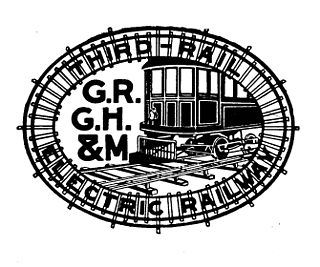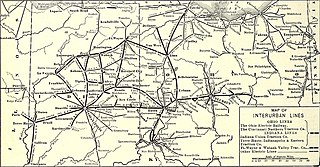
The Interurban is a type of electric railway, with streetcar-like electric self-propelled rail cars which run within and between cities or towns. The term "Interurban" is usually used in North America, with other terms used outside it. They were very prevalent in North America between 1900 and 1925 and were used primarily for passenger travel between cities and their surrounding suburban and rural communities. The concept spread to countries such as Japan, the Netherlands, Switzerland, Belgium, Italy and Poland. Interurban as a term encompassed the companies, their infrastructure, their cars that ran on the rails, and their service. In the United States, the early 1900s interurban was a valuable economic institution. Most roads between towns and many town streets were unpaved. Transportation and haulage was by horse-drawn carriages and carts.

The Cincinnati and Lake Erie Railroad (C&LE) was a short-lived electric interurban railway that operated in 1930–1939 Depression-era Ohio and ran between the major cities of Cincinnati, Dayton, Springfield, Columbus, and Toledo. It had a substantial freight business and interchanged with other interurbans to serve Detroit and Cleveland. Its twenty high-speed "Red Devil" interurban passenger cars operated daily between Cincinnati and Cleveland via Toledo, the longest same equipment run by an interurban in the United States. The C&LE failed because of the weak economy and the loss of essential freight interchange partners. It ceased operating in 1939.

The Cincinnati, Lebanon and Northern Railway (CL&N) was a local passenger and freight-carrying railroad in the southwestern part of the U.S. state of Ohio, connecting Cincinnati to Dayton via Lebanon. It was built in the late 19th century to give the town of Lebanon and Warren County better transportation facilities. The railroad was locally known as the "Highland Route", since it followed the ridge between the Little and Great Miami rivers, and was the only line not affected by floods such as the Great Dayton Flood of 1913.
The Cincinnati, Hamilton and Dayton Railway (CH&DR) was an electric interurban railway that existed between 1926 and 1930 in the U.S. state of Ohio. It was absorbed in 1930 into the new Cincinnati and Lake Erie interurban railway. In typical interurban fashion, it had its own right of way in open country, although this was often adjacent or parallel to a road. In cities and towns it operated on city streets. This included two and three car freight/express trains as well as passenger cars.

The Illinois Terminal Railroad Company, known as the Illinois Traction System until 1937, was a heavy duty interurban electric railroad with extensive passenger and freight business in central and southern Illinois from 1896 to 1956. When Depression era Illinois Traction was in financial distress and had to reorganize, the Illinois Terminal name was adopted to reflect the line's primary money making role as a freight interchange link to major steam railroads at its terminal ends, Peoria, Danville, and St. Louis. Interurban passenger service slowly was reduced, ending in 1956. Freight operation continued but was hobbled by tight street running in some towns requiring very sharp radius turns. In 1956, ITC was absorbed by a consortium of connecting railroads.
Established in 1908, the Stockton Terminal and Eastern Railroad provides service to several companies around the Stockton area, in San Joaquin County, California.
The Indiana Railroad (IR) was the last of the typical Midwestern United States interurban lines. It was formed in 1930–31 by combining the operations of the five major interurban systems in central Indiana into one entity. The predecessor companies came under the control of Midland Utilities, owned by Samuel Insull. His plan was to modernize the profitable routes and abandon the unprofitable ones. With the onset of the Great Depression, the Insull empire collapsed and the Indiana Railroad was left with a decaying infrastructure and little hope of overcoming the growing competition of the automobile for passenger business and the truck for freight business. The IR faced bankruptcy in 1933, and Bowman Elder was designated as the receiver to run the company. Payments on bonded debt were suspended. Elder was able to keep the system virtually intact for four years, and IR operated about 600 miles (970 km) of interurban lines throughout Indiana during this period. During the late 1930s, the routes were abandoned one by one until a 1941 wreck with fatalities south of Indianapolis put an abrupt end to the Indiana Railroad's last passenger operations.
The Ohio Valley Electric Railway was a street railway and interurban system that ran between Huntington, West Virginia, and Ashland, Kentucky. The system was also connected by ferry to Ironton, Ohio.

The Terre Haute, Indianapolis and Eastern Traction Company, or THI&E, was the second largest interurban in the U.S. state of Indiana at the 1920s height of the "interurban era." This system included over 400 miles (640 km) of track, with lines radiating from Indianapolis to the east, northwest, west and southwest as well as streetcar lines in several major cities. The THI&E was formed in 1907 by the Schoepf-McGowan Syndicate as a combination of several predecessor interurban and street car companies and was operated independently until incorporation into the Indiana Railroad in 1931. The THI&E served a wide range of territory, including farmlands in central Indiana, the mining region around Brazil, and numerous urban centers. Eventually, it slowly succumbed like all of the other central Indiana interurban lines, to competition from automobiles, trucks, and improved paralleling highways.
The Youngstown and Ohio River Railroad, or Y&OR, was one of the smaller interurban railways in the state of Ohio. Along with the Youngstown and Southern Railway, the Y&OR formed a traction link between Youngstown, Ohio and the Ohio River at East Liverpool. It served several coal mines in the area and it was distinguished by the unusual feat of electrifying a section of a steam railroad, the Pittsburgh, Lisbon and Western Railroad, as part of a trackage rights agreement. The Y&OR operated for 24 years.

The Grand Rapids, Grand Haven and Muskegon Railway was an electric interurban railway that operated in west Michigan from 1902 until 1928.

The Detroit United Railway was a transport company which operated numerous streetcar and interurban lines in southeast Michigan. Although many of the lines were originally built by different companies, they were consolidated under the control of the Everett-Moore syndicate, a Cleveland-based group of investors. The company incorporated on December 31, 1900, and continued to expand into the early 1920s through new construction and the acquisition of smaller concerns. After the DUR acquired the Detroit-Jackson line in 1907, it operated more than 400 miles (640 km) of interurban lines and 187 miles (301 km) of street city street railway lines.

The Interurban Bridge, also known as the Ohio Electric Railroad Bridge. is a historic interurban railway reinforced concrete multiple arch bridge built in 1908 to span the Maumee River joining Lucas and Wood counties near Waterville, Ohio. The span was once the world's largest earth-filled reinforced concrete bridge. One of the bridge's supports rests on the Roche de Boeuf, a historic Indian council rock, which was partially destroyed by the bridge's construction. The bridge, which is no longer in use, is a popular subject for photographers and painters, who view it from Farnsworth Metropark.
Michigan United Railways (MUR) was an interurban which owned and leased numerous lines in the state of Michigan during the early twentieth century.

The Lansing, St. Johns and St. Louis Railway was an electric interurban railway which briefly operated independently in central Michigan during the early 20th century. It was the site of a failed attempt to introduce alternating current to the interurban scene.
The Cincinnati Northern Railroad was a railroad that stretched from Franklin, Ohio, north to Jackson, Michigan, a distance of about 186 miles (299 km). It was acquired by the Cleveland, Cincinnati, Chicago and St. Louis Railway in 1901 and the New York Central Railroad several years later. Most of the line has since been abandoned.
The Syracuse, Lake Shore and Northern Railroad, an interurban railway, was incorporated on September 9, 1905, after it was purchased by the Beebe Syndicate. The line ran from Syracuse, New York, to Baldwinsville, New York, a distance of 14 miles (23 km) with a short branch to the New York State Fair grounds ending at Long Branch Park west of the city for a total of 23.53 miles (37.87 km) of electric track.

The Ohio Electric Railway was an interurban railroad formed in 1907 with the consolidation of 14 smaller interurban railways. It was Ohio's largest interurban, connecting Toledo, Lima, Dayton, Columbus, and Cincinnati. At its peak it operated 617 miles (993 km) of track. Never financially healthy, the company went bankrupt in 1921 and was dissolved into its constituent companies.










